Release Date: April 11th, 1942
Series: Looney Tunes
Director: Friz Freleng
Story: Dave Monahan
Animation: Manny Perez
Musical Direction: Carl Stalling
Starring: Reid Kilpatrick (Narrator, Proprietor), Mel Blanc (Vulture, Thirsty Man, Cat, Voice, Nasty Hombre, Horse, Scared Horse), Billy Bletcher (Cactus Pete)
(You may view the cartoon here!)
As the months and years go on, the relevance of black and white cartoons within the Warner studio was steadily dwindling. It would be by the next year that they were phased out entirely; budgetary concerns weren't as restrictive as they once were, and the growing talent and ability of the entire studio seemed to demand more than the restrictions of monochrome, which were often viewed as the lesser step sister to the prestigious color Merrie Melodies.
Thus, Saps in Chaps marks Friz Freleng's final foray into black and white (his Private SNAFU cartoons for the government not withstanding.) Freleng's first directorial stint in the '30s saw him adopting the senior unit of the studio, rarely mingling with the black and white Looney Tunes; thus, the transition to full color isn't as momentous as it may be to someone like Bob Clampett, who exclusively directed black and white cartoons for the first four years of his career, but it certainly is a shift worth noting.
Similar applies to the credit of one Dave Monahan. Notably credited with the prestige of Sergeant, this short and Freleng's next effort, Lights Fantastic, would be the last two Warner shorts bearing his name until a five year absence. The honorific in his credit speaks for itself. Indeed, the landscape of the cartoon studio would be quite different after his return from the war; he would lend his writing prowess to a handful of cartoons under the supervision of Art Davis--Mexican Joyride, Catch as Cats Can, Nothing but the Tooth and The Rattled Rooster--before transitioning to the Columbia Screen Gems studio in its last days.
As far as final B&W shorts go, Saps in Chaps is standard, mostly inoffensive fare. The novelty of a short being released under the Looney Tunes series with no Porky was still relatively fresh at this time, if nothing else. Constructed in the mold of the ever revered Tex Avery spot gag cartoon, Saps places a focus on all things cowboys: vast deserts, wagon trains, rodeos, confrontational gunslingers, and unobliging horses.
On the topic of swan songs, narrator Reid Kilpatrick offers his final cartoon performance in this very short as its designated narrator. His career in film still had a good handful of years left for him, but, as far as the Warner cartoon department was concerned, the role as the ever beloved condescending travelogue narrator was not in hot demand as it was around three years prior.
Kilpatrick nevertheless puts in the oratory mileage for this cartoon, essentially narrating a stretch of 50 seconds as the cartoon presents its opening to the audience. Given how static the opening is--50 seconds of one continuous camera pan, stopping only for the occasional sight gag--his inclusion is a necessity in contributing further energy and intrigue.
Through a geographically vague and politely incorrect map, the camera follows an animated dotted line as it treks through the plains to head west. The black hills of South Dakota are approached with an Avery-esque literality--same with the Colorado Rockies, whose backbone of the nation is approached with synonymous dutifulness in gag sense, and the same to the painted desert.
Out of the entire sequence, the most notable gag proves to be an homage to Mount Rushmore. Kilpatrick introduces the gag through more punny literality: "...in the days when the west was young". Intriguingly, the gag has a bit of a double-meaning, as the monument had just completed construction in October of 1941 (as evidenced by the exposed bits of scaffolding seen here). While still polite, the gag commands the most attention out of its companions through a directorial conviction. No other visual gags receive the same benefit of a change in music--"We Did It Before and We Will Do It Again"--or the prestige of the camera coming to an actual stop. It's clear that this is the intended highlight.
The seemingly interminable camera pan finally comes to a halt and succumbs to a cross dissolve on the topic of endurance. Sure enough, a haggard, decrepit, decidedly Cal Dalton animated cowpoke trudges his way through the scorching desert, his only company being the lonely sound of Stalling's western musical orchestrations. Dalton imbues the traveler's lolling tongue with a particularly strong sense of weight, tangible in its floppiness and its conveyance of dehydration. Visuals are confident enough to sell any and all sympathy on behalf of the weary traveler, but the motion is exaggerated to politely laugh at just the same. A punchline surely lies on the other side.
Such is evidenced through a jump cut to a pair of buzzards flying in the sky; sudden as their appearance may seem, the transition abrupt even despite the length of the scene with the traveler lending itself to availability for a transition, their soft, cartoon appearance seeks to take the edge off any extended sympathy to the suffering vagabond. Cartoon buzzards are here, which means antics and humor are abound.
"Hey, Joe! I got a bone ta pick wit' you!" likewise reaffirms as such. From the head tilts to the occasionally squinted eyes to the wrinkled mouths, Dalton's touch seems to extend to this little cutaway gag that is never mentioned again.
Seeing the traveler receive the euphoria of quenching his thirst takes priority over any comedic shenanigans involving buzzards; as mentioned before, their tangent seems to be a quick way to lighten the mood and secure a laugh. Perhaps a sign of insecurity with the "story", given that the entirety of the cartoon has consisted of monotonous pans--some just a bit more decorative and busy with their details.
Tight framing of the composition and cutting of the screen can't entirely impede the joke of the refreshment, singular, stand bearing the ironic branding of "Custer's Last Stand". Sheer convenience of the stand and its intricacy--at least, in comparison to the man guzzling water from a nearby pump or something more primitive--point the gag in the direction of success.
That, and sheer loyalty. From the shots of the man crawling to him collapsing at the stand, from the attendee giving him water and encouraging him to take it slow to the traveler's recovery, the sequence stretches on for quite awhile. Monotony of the cartoon's opening minute may impede the effect here, exacerbating any intentional tedium beyond preferability, but the dedication to every little beat offers a solid ground that seldom registers to the same degree elsewhere in the cartoon.
Especially considering that all of this laborious build-up--the crawling, the fainting, the rescuing, the guzzling, the thanking--amounts in a deeply ironic bookend as the traveler resumes back to all fours, tongue lolling, forlorn musical accompaniment weeping alongside him. Actually having the traveler walk like a regular human being for a few seconds renders the contrast all the more sharp through subverting audience expectations.
Brief technical note: attuned eyes will note that as the camera resigns itself to a fade out, the traveler engages in another crawl cycle that goes unreciprocated by the background. With the background pan not moving ahead, he momentarily seems to writhe in place instead--the thinking seemed to be that the fade would obscure the error well enough, which, for audiences in 1942, was likely true. The gift of freeze framing and instantaneous access to cartoons is not such a gift to any creatives hoping their menial mistakes will be free of obsessive eyes.
Spotlighting the trajectory of a literal wagon train may not bring any comedic freshness or newfound inspiration--shorts such as Inj*n Trouble boast seniority on the gag--but it does open an avenue for a change in staging and tone. Juxtaposed against the interminable camera pans left, no matter how occupied or unoccupied they may be my an animated subject, having the wagon train come in from the foreground and slope into the distance serves as a cinematic sanctuary against monotonous staging. As far as sheer cinematics go, this is the most adventurous the cartoon gets.
Aside from the passengers in the caboose of the train, gag sense extends to the train's branding; fleetingly, the vessel brands itself as the ever ironic "Schooner Limited". Schooner being the name of a sailboat with multiple masts, and the Limited title serving as an inverse for the many Unlimited trains proudly touted around that time.
"And over the wild stretches of these prairie lands, towns sprang up like mushrooms!"
Kilpatrick's narration is called into action. Intensity of the visual, both in speed and quantity, could stand to be pushed. One can't help but imagine how Tex Avery would have handled the same gag if this short were under his own domain--answering the narration is one thing, but to put conviction behind it is another, of which this lacks.
Nevertheless, a comedically reticent outhouse offers an amusing enough topper to boost morale. Treg Brown's sound effects (and Bob Clampett's, his verbal "BOING!" accompanying the outhouse) offer a necessary tangibility to the visual metaphor.
Talk of towns thusly initiates a more intimate view of one of these villages, ushered through a cross dissolve to formally move the cartoon beyond any vestiges of exposition. This in itself spawns a somewhat laborious but nevertheless "cute" segment introducing the cowpoke denizens to the audience, all proudly bow-legged in their walk cycles--even the horses are in it. Complaints of arduousness are reserved more for the pacing, which lingers on the scene much longer than necessary. In all, the scene only lasts about ten seconds, but feels longer. Waiting for a bow-legged horse to traipse in for the sake of a riotous punchline doesn't garner the impact that seemed to be intended.
Even the mice contribute to upholding this bow-legged custom. A change of layout and adjustment in the framing indicates that the mouse is there to offer more than just completionism for a visual gag; our attention is commanded.
As is his--a surprised take is directed towards an unknown entity, which prompts him to scurry off, much to the ponderance of the audience. Sure enough, in enters a mouse cow roping cat. Abstaining his reveal until the last possible second proves to be an effective way to drum up any semblance of anticipation and excitement; a greater sense of accomplishment is aroused when there are fewer visual or auditory cues to give away what comes next (even if it may seem obvious in hindsight).
Like most of the gags in the short, it certainly isn't nothing riotous, but its commitment to the bit is appreciated-the yipping of the cat, the availability of the lasso, Stalling's flurried, exciting score. Quality of the surviving cartoon print impedes the view (as well as the cat locked in a constant cycle of movement), but a close analyzation of the cat will reveal that he has patches on his back and knee to not only give him a haggard and antagonistic appearance, but could be seen as placeholders for patches of leather, like with a "real" cowpoke's outfit.
Most western themed shorts of this era fold into an obligation to mention the pony express in some form. Its relevance to this short is a bit more pronounced than others, in terms of recurrence--it is through this introduction that the short indulges in its "B plot": a pony express rider struggling to hop onto his horse.
Variance in the cycle repeated throughout the short helps to ease any monotony--for example, the cowpoke jumps a few times, hanging onto the horse's saddle instead of being locked in an unbroken run cycle, which would put the gag's expiration date much sooner. Ditto with the occasional perspective animation and shift in view. Demonstrating the horse and cowboy turning over a hill and running into the horizon gives a tangibility to the gag, a confirmation that these run cycles don't exist in a repetitious void but are indeed being exerted by perceptible characters. Stalling's lopsided theme of "Light Cavalry Overture" offers these segments with a certain self awareness through repetition that translates into security.
Brief background note: Gil Turner receives a shoutout by way of signage.
For the next handful of segments, the narrator adopts the back seat. Fluctuation of the narrator's involvement has always been a deceptively important facet to the success of a travelogue. Constant spoon feeding of information may err a bit too zealously on the side of condescension beyond intention--that, and to have every action prefaced and explained gets exhausting. Abstinence of his speech keeps the short's pacing varied which, in turn, provokes further intrigue from the audience.
The following spotlights explain themselves comfortably enough not to need such verbal assistance. Exhibit A: a cowboy demonstrating his tobacco rolling skills--lampooned in other western shorts such as Egghead Rides Again and My Little Duckaroo--ends up with a severe case of twisted fingers in his haste to impress. Grotesqueness of the final image, flapping sound effects accompanying the process of getting there and appealing, elastic, deft animation from Dick Bickenbach all point to its success.
Similar comments apply to a cowpoke showing off his "wedgies": this close-up of his disfigured, bulging boot and the leg therein receives the prestige of a painting. The tobacco gag receives extra points for extra commitment--no matter how marginal--but both tangents fit together well as exactly that: tangents.
Now, the camera indulges in a cross-dissolve and pan combo to take the audience into a change of scenery: the saloon. Paintings of pin-up girls and goings-on of gambling attempt to offer a comparatively more gritty tone, but, in comparison to other efforts, remains relatively wholesome in its image. Tenderfoots are welcomed to carouse and amble, make friendly conversation rather than offer an imposing glimpse to the hard broiled life of a cowboy.
Eye blink lines and a collective surprised take reveal Dick Bickenbach to be the purveyor of this brief crowd sequence...
...and beyond. A fleeting focus on a humorously obtuse villain (obligatory mustache and top hat in check) is all handled by Bickenbach. The sequence certainly isn't as visually ambitious as his many other works--unless one were to count the sheer volume of incidental characters he had to animate, which proves to be a chore no matter how stagnant their movement--but nevertheless strikes out on appeal in draftsmanship and energy.
A fine companion piece to the culmination of his introduction: if there was one word to describe the deep, reverberating belly laughs of Billy Bletcher, honoring the narrator's sermonizing about his heroic tendency to laugh in the face of danger, that word would indeed be "energetic". Rich, booming, and steering on the manic side, Bickenbach captures the ecstacy of the cowboy quite well through his convulsing and fist pumping. Most of the acting and movement seems to be relegated to the face, but, given that the segment is so reliant on listening to Billy Bletcher laugh, the prioritization is warranted.
Compared to the contents of the entire short, the sequence is a bit anticlimactic beyond intent, but nevertheless memorable through directorial dedication. Casting Bletcher as the hero and not the villain was a great choice on Freleng's behalf; throughout the '30s especially, Bletcher's iconic bass tones could be heard in practically every cartoon that featured a villain. It would have been an easy impulse to cast him as the villain, and Blanc as the manic, hysterical cowboy. Instead, this swapping of expectations offers a surprising richness that doesn't seem like it would have been reciprocated the other way around. Perhaps the novelty of hearing Bletcher outside of his usual typecasting is just particularly strong.
Rewarded for our patience, the horse and his inept rider make a rebound through another spotlight. More measures are taken in ensuring the gag doesn't wear out is welcome as quickly as it could: something more subtle, such as additional music chords accentuating the act of the cowboy struggling to jump onto the saddle, or perhaps something a little more notable, such as the "rider" exchanging horses as if in a track relay.
Even with these measures in mind, the segment does still skew on the side of tedium. Shaving a few seconds off of the literal run-time would certainly prove helpful. After the cowboy has exchanged horses, the screen doesn't need to follow him as long as it does in its current condition. Nevertheless--no matter the rate of success--the subtleties such as layered music or layered gags are appreciated in the effort to curb monotony.
The strongest semblance of continuity within the short (barring the aforementioned recurring rider) stems from a spotlight covering various rodeo related gags. As is customary for introducing these longer stretches, the action first operates at a conventional, digestible pace before rising into a crescendo of growing lunacy. Rotoscoped animation of a cowboy on his horse (yipping sound effects reused from the cat from before) serves as the martyr for the sake of innocuousness. One could count the Friz Freleng in-joke with the "Frisby County" labeling on the poster as a playful prodding of mischief, which is true, but the introduction remains largely stolid for the sake of easing the audience in.
That way, audiences are better prepared for the next gag: a cowboy demonstrating his "brute strength", as expatiated by the narrator, and having his legs shred into practically nothing from the force of his scuffing. Another gag that isn't particularly groundbreaking, but it proves serviceable enough for this short--nice innocuous opening, comfortable animation and draftsmanship--squealing sound effects from Treg Brown and effects animation of sparks coming out of the cowboy's heels as he slides support the accompanying visuals.
A beat is offered for the cowboy to gawk at the camera and strut away accordingly; all the more for audiences to laugh at and absorb the joke.
Next up: horse jumping, in which the horse actually jumps a real athletic high jump to the wild subversion of audience expectations. Elasticity on the horse's legs proves to be a nice change, demonstrating that Freleng is getting more comfortable in leaning into the more exaggerated properties of the rodeo--no longer is there an obsessive need to play it straight. That, and the motion just looks nicer as a result. Anything to detract prying eyes from the positively ghastly crowd shots in the background (which, in fairness, is likely exacerbated in its ghoulishness through the murky VHS print).
Yipping sound effects find reuse for a third time now, accompanying another bucking bronco not dissimilar to the rodeo's expositional moments.
At least until the horse is challenged by the narrator's delighted condescension. Observations of "He'll never throw this boy!" are reciprocated through the horse pausing, glaring at the camera, and throwing the boy in question off his back. Similar gags have and will again be repeated, but the childish attitude of the horse--particularly clinched through sticking his tongue out to the camera--gives it a little boost. Especially in comparison to the stolid opening. Freleng's gradual wading into zany punchlines is felt and appreciated.
Another haughty exit mirrors that of the stubby cowboy seen in just prior. It fits for the demands of this particular scene here, but does prompt some of the directorial momentum to deflate through such back-to-back repetition.
"And now for the big event!" subconsciously cues the audience into bracing for the gradual end of the cartoon. About a minute of runtime remains, so the end isn't exactly nigh, but there is a sense of finality and anticipation in the narrator's dialogue that places inflated expectations on what this penultimate spotlight will entail.
Not much. Granted, the entire point of the sequence is to exemplify an anticlimax, and it certainly does succeed: a cowboy preparing to ride an aggressive, brutish horse proves to have little difficulty when the horse succumbs to his stage fright. Chuck Jones perhaps boasts the most memorable twist on a character's stricken observation of "People..." with Hare-Raising Hare, but the subverting of expectations and wimpiness of Blanc's delivery for the horse works well here.
Construction of suspense and tangibility of the crowd are some of the biggest takeaways of success. Emphasis on danger and excitement are established by the narrator and justified through the actions on-screen--the fellow cowboys helping to orchestrate the event seem fearful and quick to escape, which, again, is justified through angry whinnying and bulging of the gate doors.
Conversely, unlike other scenes, the crowd is actually animated (and rather laboriously at that), which certainly offers meaning behind the horse's hesitance. An effect that most certifiably wouldn't be the same if the crowd were relegated to the same ghoulish background paintings touted before.
As if Freleng or Monahan felt that the sequence was too flimsy of an anticlimax climax, a hasty, below-the-belt addition is made to compensate. Aside from flagrant racism and dehumanization, arbitrariness of the gag (at best) stems from its inclusion at all. It doesn't support the flow of shots, it doesn't support anything being accomplished by the sequence. Instead, it's just an idea thrown at the wall and translates as such on film--its repugnance just happens to be an additional feature.
Nevertheless, monologuing of the narrator atop a moody western panorama sees the audience out the door, Stalling's contented, sleepy orchestrations of "Ride, Tenderfoot, Ride" in check...
...only to be replaced by the familiar strains of the Light Cavalry Overture, which can only mean one thing.
Operating under the fabled rule of threes, the final appearance of a horse and its "rider" offers a subversion through the convenience of an overlay obscuring the change. While nothing new to audiences of 2024 or 1942, the change is effective through the repeated build-up all through the cartoon and assuming the rule of threes. There's a sense of true payoff--at least someone has earned a ride.
Not dissimilar to quite a handful of travelogues--especially those not by Tex Avery--Saps in Chaps does seem to revel in its status as a bit of comedic filler. Directorial dedication seen in The Wabbit Who Came to Supper is certainly absent here, which compels one to speculate on whether or not Saps was rushed or cast aside in further favor of Wabbit. Or, if Wabbit was such a directorial chore that Freleng needed a quota-filler to help recuperate. Either is plausible.
Thankfully, Saps doesn't feel as disposable as other shorts in the same vein. It may be aggressive in its unremarkability, but feels as if it's on a different standing artistically than shorts conducted in a similar vein, like Sport Chumpions or Rookie Review. Draftsmanship certainly feels more tight than the aforementioned efforts, and despite the tangential-by-nature format of these spot gags, there does seem to be a broader sense of narrative focus in this one than the others.
With these reviews, "it meets the quota" does give the impression of unfavorability, and that can often be true. However, it's a cause that is noble just the same. Not every cartoon can be The Wabbit Who Came to Supper. By proxy, not every cartoon should be. Meeting a deadline and offering an opportunity for the audience to laugh and relax is as good a mission as any. Some shorts are more prestigious, more decorative, more aggressive in the means that they accomplish these tasks, but the ones that lack such frills shouldn't be punished by comparison.
Saps is a serviceable cartoon--the trouble just comes in when knowing that Freleng's talent is beyond such a label.



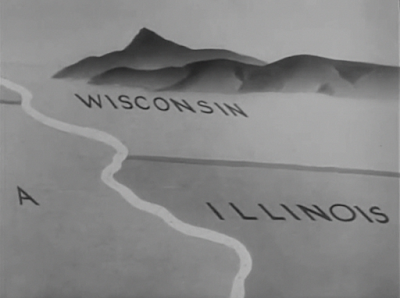









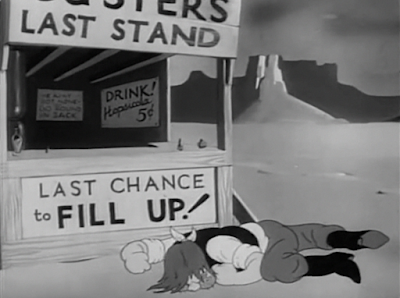






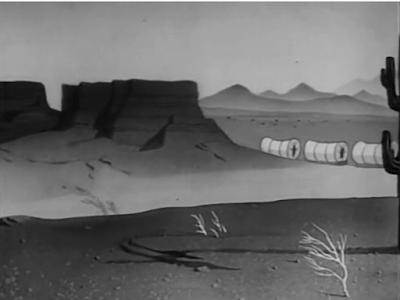















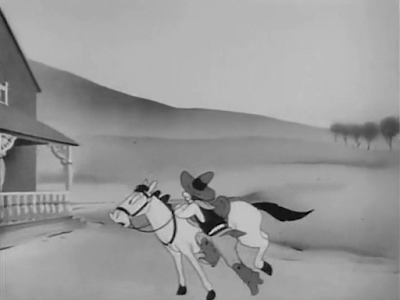










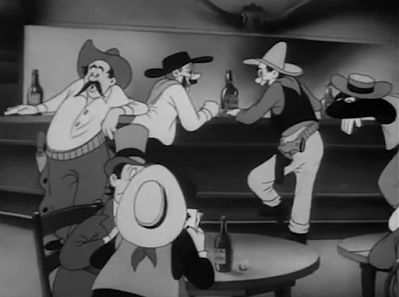
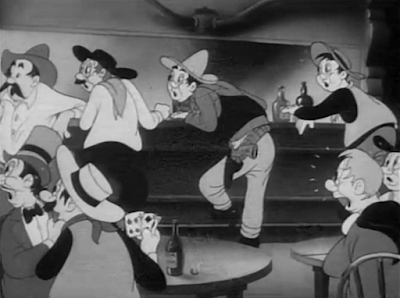
















































No comments:
Post a Comment